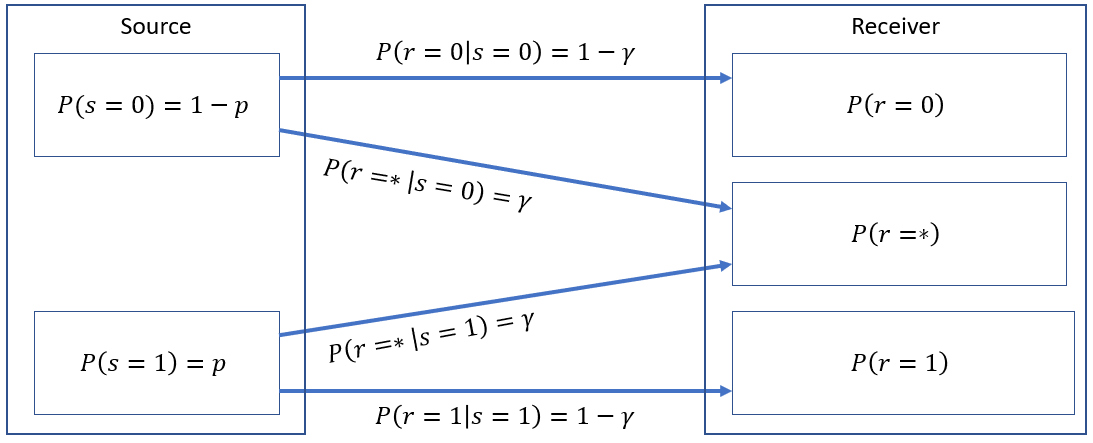Difference between revisions of "2S2122 Activity 3.1"
Ryan Antonio (talk | contribs) |
Ryan Antonio (talk | contribs) |
||
| Line 93: | Line 93: | ||
=== Problem 3.a Binary Erasure Channel === | === Problem 3.a Binary Erasure Channel === | ||
| + | |||
| + | A '''Binary Erasure Channel (BEC)''' is shown below: | ||
| + | |||
| + | [[File:Binary erasure ch.PNG|frame|center|Binary Erasure Channel]] | ||
| + | |||
| + | BEC is an interesting channel because it has 3 different outputs. The received values <math> 0</math>, <math> 1</math>, and <math> * </math>. This channel assumes that we can erase or throw unwanted values into the trash bin. It's worth investigating! 😁 Show your complete solutions and box your final answers. | ||
| + | |||
| + | |||
| + | 1. Determine the probabilities: | ||
| + | |||
| + | * <math> P(r = 0)</math> | ||
| + | * <math> P(r = 1)</math> | ||
| Line 105: | Line 117: | ||
| − | + | <math> </math> | |
| − | |||
== Huffman Coding == | == Huffman Coding == | ||
Revision as of 19:26, 2 March 2022
Contents
Problem 1 - The Complete Channel Model (2 pts.)
Answer comprehensively and do the following:
1. Draw the complete channel model. (0.2 pts)
2. What is the source? (0.2 pts)
3. What is the channel? (0.2 pts)
4. What is the receiver? (0.2 pts)
5. What are the encoder and decoder? (0.2 pts)
6. What are codebooks? (0.2 pts)
7. What is coding efficiency? (0.2 pts)
8. What is the maximum capacity of a channel? (0.4 pts)
9. What are symbol rates? (0.4 pts)
10. Where is Waldo? (if we like your answer you get 0.2 pts extra)
Problem 2 - Review of BSC (2 pts.)
1. Draw the BSC channel with correct annotations of important parameters and . (0.1 pts) 2. Fill up the probability table in terms of the important parameters: (0.1 pts each entry)
| Probability Term | Function |
|---|---|
3. Fill up the table below with the measures of information. Answer only in terms of and parameters (and of course constants). When necessary you can use "let be ...". Also, answer with equations that are programming friendly. Answering the simplified version merits half points for that part. (0.1 pts per term)
| Information Measure | Function |
|---|---|
4. Explain why when regardless of varying the source probability distribution . (0.2 pts.) 5. Explain what does negative information mean and when can it happen? (0.2 pts.) 6. Explain why means information from the receiver can short-circuit back to the source. (0.1 pts.)
Problem 3 - CRAZY Channels
Problem 3.a Binary Erasure Channel
A Binary Erasure Channel (BEC) is shown below:
BEC is an interesting channel because it has 3 different outputs. The received values , , and . This channel assumes that we can erase or throw unwanted values into the trash bin. It's worth investigating! 😁 Show your complete solutions and box your final answers.
1. Determine the probabilities:
Problem 3.b Binary Error and Erasure Channel
Problem 3.c Binary Cascade Channel























